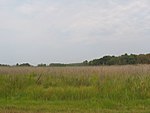Mattapax
Eastern Shore, Maryland Registered Historic Place stubsHouses completed in 1760Houses in Queen Anne's County, MarylandHouses on the National Register of Historic Places in MarylandKent Island, Maryland ... and 1 more
National Register of Historic Places in Queen Anne's County, Maryland

Mattapax is a historic home located at Stevensville, Queen Anne's County, Maryland, United States. It is a 1+1⁄2-story brick house, three bays wide, and one room deep, with flush brick chimneys at either end of a pitched gable roof built about 1760. In 1949 a restoration resulted in the construction of a brick wing to replace an earlier frame wing. Also on the property are a frame cottage, a large horse barn, and a frame wagon shed.It was listed on the National Register of Historic Places in 1998.
Excerpt from the Wikipedia article Mattapax (License: CC BY-SA 3.0, Authors, Images).Mattapax
Shipping Creek Road,
Geographical coordinates (GPS) Address Nearby Places Show on map
Geographical coordinates (GPS)
| Latitude | Longitude |
|---|---|
| N 38.911111111111 ° | E -76.348333333333 ° |
Address
Shipping Creek Road
21666
Maryland, United States
Open on Google Maps





